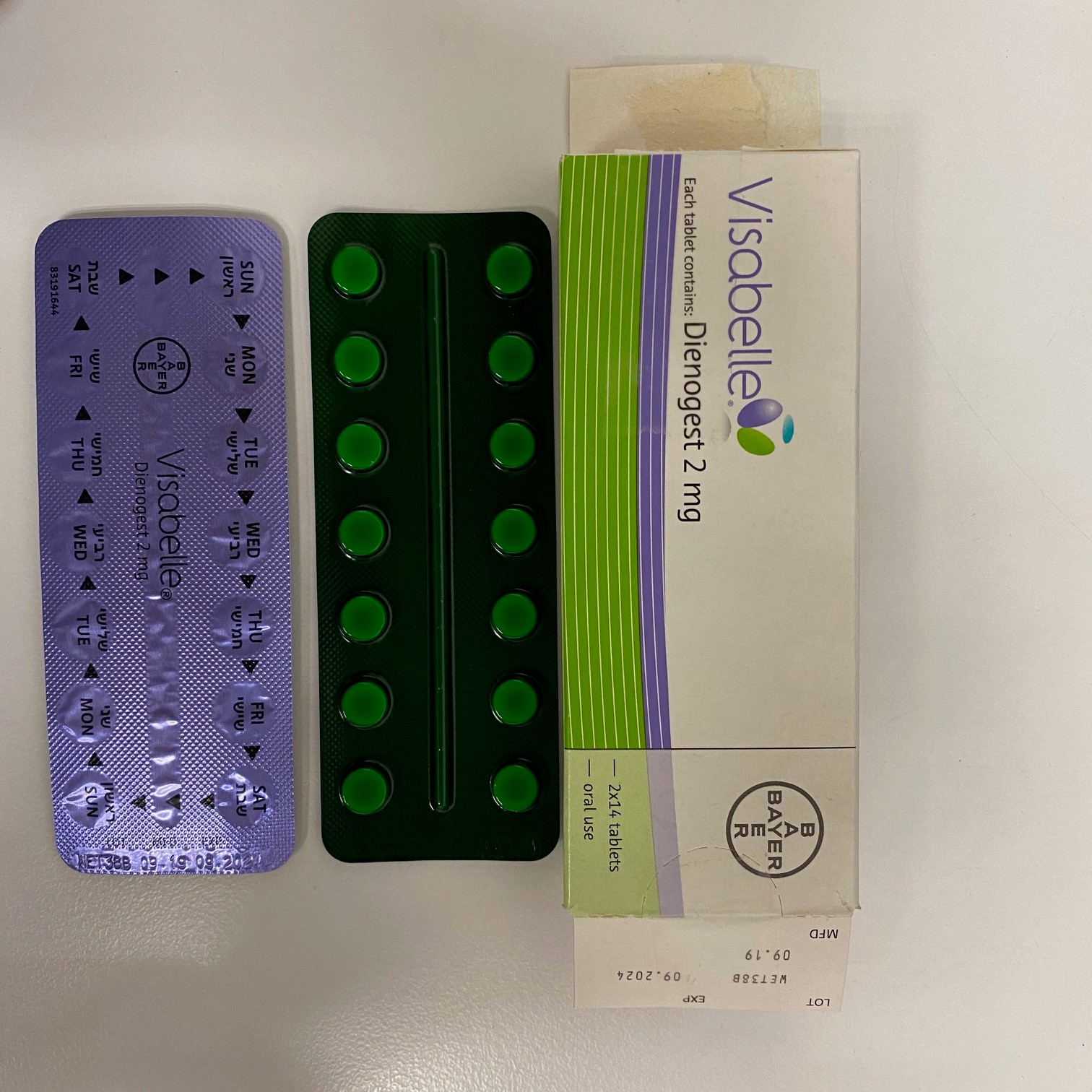Quest for the right Drug

ויזאבל VISABELLE (DIENOGEST)
תרופה במרשם
תרופה בסל
נרקוטיקה
ציטוטוקסיקה
צורת מתן:
פומי : PER OS
צורת מינון:
טבליה : TABLETS
עלון לרופא
מינוניםPosology התוויות
Indications תופעות לוואי
Adverse reactions התוויות נגד
Contraindications אינטראקציות
Interactions מינון יתר
Overdose הריון/הנקה
Pregnancy & Lactation אוכלוסיות מיוחדות
Special populations תכונות פרמקולוגיות
Pharmacological properties מידע רוקחי
Pharmaceutical particulars אזהרת שימוש
Special Warning עלון לרופא
Physicians Leaflet
Adverse reactions : תופעות לוואי
4.8 Undesirable effects Presentation of undesireable effects is based on MedDRA. The most appropriate MedDRA term is used to describe a certain reaction and its synonyms and related conditions. Undesirable effects are more common during the first months after the start of treatment with Visabelle, and subside with continued treatment. There may be changes in bleeding pattern, such as spotting, irregular bleeding or amenorrhea.The following undesirable effects have been reported in users of Visabelle. The most frequently reported undesirable effects under treatment with Visabelle are headache (9.0 %), breast discomfort (5.4 %), depressed mood (5.1 %) and acne (5.1 %). In addition, the majority of patients treated with Visabelle experience changes in their menstrual bleeding pattern. Menstrual bleeding patterns were assessed systematically using patient diaries and were analyzed using the WHO 90 days reference period method. During the first 90 days of treatment with Visabelle the following bleeding patterns were observed (n=290; 100%): Amenorrhea (1.7%), infrequent bleeding (27.2%), frequent bleeding (13.4%), irregular bleeding (35.2%), prolonged bleeding (38.3%), normal bleeding, i.e. none of the previous categories (19.7%). During the fourth reference period the following bleeding patterns were observed (n=149; 100%): Amenorrhea (28.2%), infrequent bleeding (24.2%), frequent bleeding (2.7%), irregular bleeding (21.5%), prolonged bleeding (4.0%), normal bleeding, i.e. none of the previous categories (22.8%). Changes in menstrual bleeding patterns were only occasionly reported as adverse event by the patients (See adverse event table). The frequencies of adverse drug reactions (ADRs) by MedDRA system organ classes (MedDRA SOCs) reported with Visabelle are summarized in the table below. Within each frequency grouping, undesirable effects are presented in order of decreasing frequency. Frequencies are defined as common (≥1/100 to <1/10) and uncommon (≥1/1,000 to <1/100). The frequencies are based on pooled data of four clinical trials, including 332 patients (100%). Table 1, Adverse reactions table, phase III clinical trials, N= 332 System Organ Class Common Uncommon Blood and lymphatic Anemia system disorders Metabolism and Weight increase Weight decrease nutrition disorders Increased appetite System Organ Class Common Uncommon Psychiatric disorders Depressed mood Anxiety Sleep disorder Depression Nervousness Mood swings Loss of libido altered mood Nervous system Headache Autonomic nervous system imbalance disorders Migraine Disturbance in attention Eye disorders Dry eye Ear and labyrinth Tinnitus disorders Cardiac disorders Unspecified circulatory system disorder Palpitations Vascular disorders Hypotension Respiratory, thoracic Dyspnoea and mediastinal disorders Gastrointestinal Nausea Diarrhoea disorders Abdominal pain Constipation Flatulence Abdominal discomfort Abdominal distension Gastrointestinal inflammation Vomiting Gingivitis Skin and subcutaneous Acne Dry skin tissue disorders Alopecia Hyperhidrosis Pruritus Hirsutism Onychoclasis Dandruff Dermatitis Abnormal hair growth Photosensitivity reaction pigmentation disorder Musculoskeletal and Back pain Bone pain connective tissue Muscle spasms disorders Pain in extremity Heaviness in extremities Renal and urinary Urinary tract infection disorders Reproductive system Breast discomfort Vaginal candidiasis and breast disorders Ovarian cyst Vulvovaginal dryness Hot flushes Genital discharge Uterine / Vaginal bleeding Pelvic pain including spotting Atrophic vulvovaginitis System Organ Class Common Uncommon Breast mass Fibrocystic breast disease Breast induration General disorders and Asthenic conditions Oedema administration site Irritability conditions Decrease of bone mineral density In an uncontrolled clinical trial with 111 adolescent women (12 to <18 years) who were treated with Visabelle, 103 had BMD measurements. Approximately 72% of these study participants experienced a decrease in BMD of the lumbar spine (L2-L4) after 12 months of use (see section 4.4). Reporting of suspected adverse reactions Reporting suspected adverse reactions after authorisation of the medicinal product is important. It allows continued monitoring of the benefit/risk balance of the medicinal product. Any suspected adverse events should be reported to the Ministry of Health according to the National Regulation by using an online form https://sideeffects.health.gov.il/

שימוש לפי פנקס קופ''ח כללית 1994
לא צוין
תאריך הכללה מקורי בסל
לא צוין
הגבלות
לא צוין
מידע נוסף
